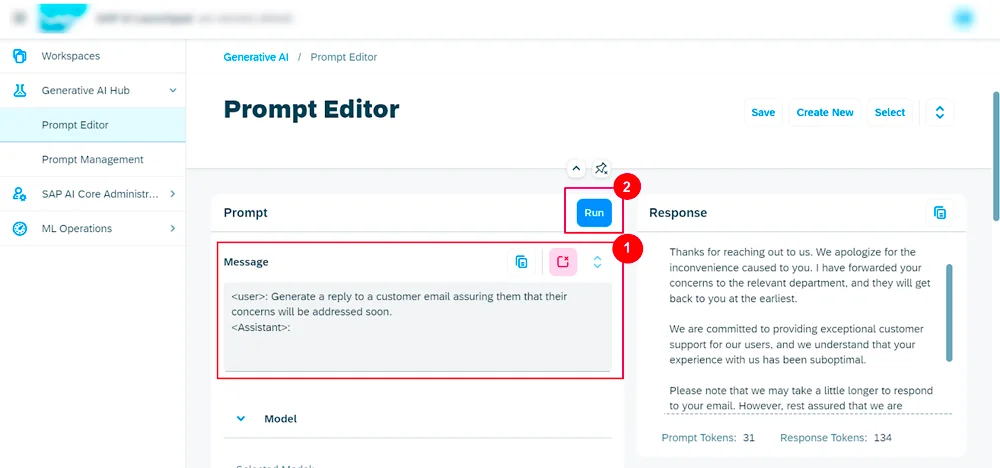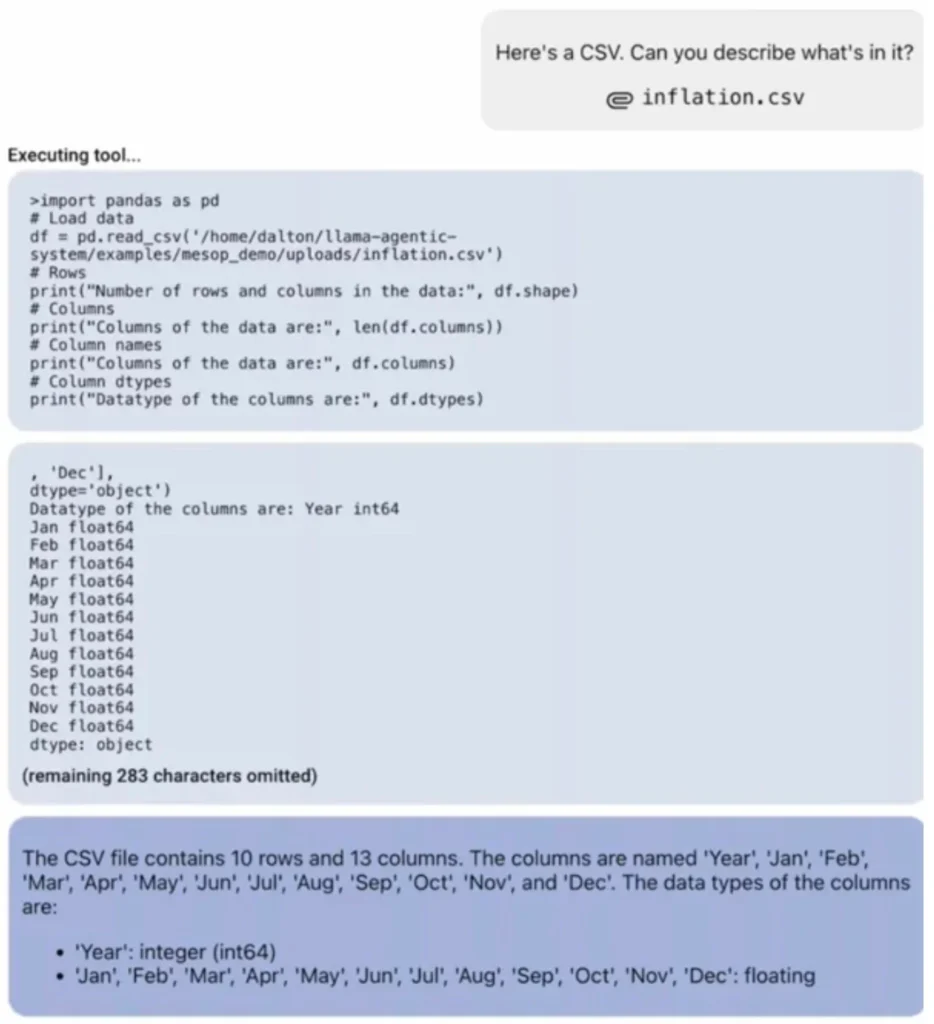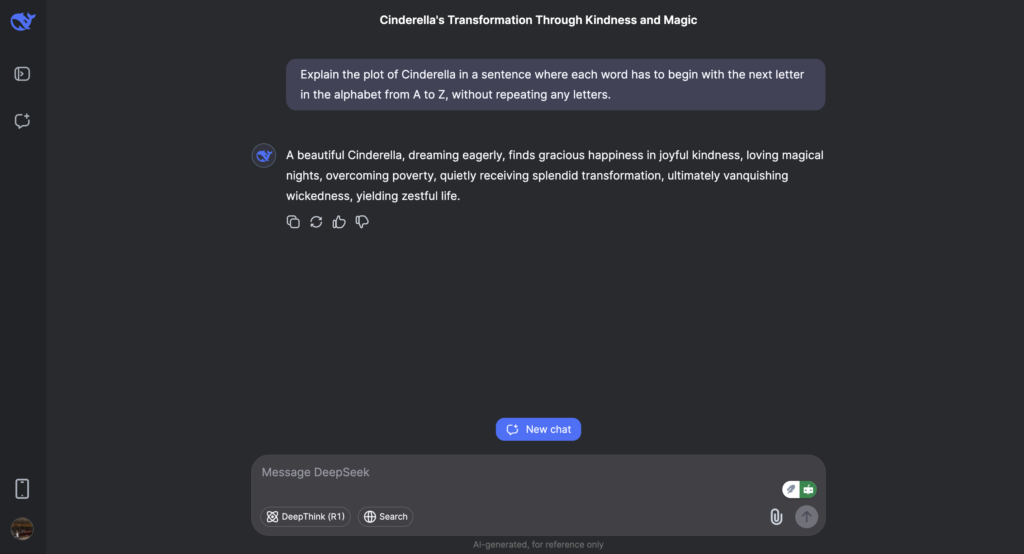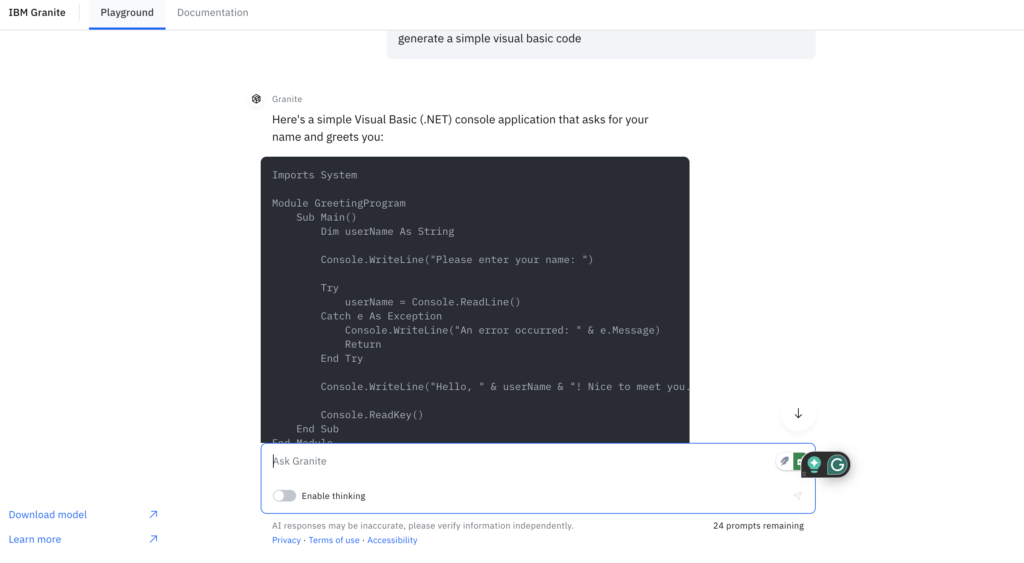Large language models (LLMs) are advanced software systems that use AI technologies such as deep learning and neural networks to perform complex tasks, including text generation, sentiment analysis, and data interpretation.
The best LLMs understand and generate human-like text; which means they can help you write social media posts and ad copy, craft personalized responses to customer inquiries, summarize data for decision-making, and even help your team in brainstorming new ideas that drive innovation. You can integrate top LLMs into your existing software platforms to improve efficiency, and unlock new functionality and automation opportunities.
Here are my picks for the best large language models for your business.
- GPT-4: Best for coding and development
- Falcon: Best for a human-like, conversational chatbot
- Llama 3.1: Best for a free, resource-light, customizable LLM
- Cohere: Best enterprise LLM for a company-wide search engine
- Gemini: Best for an AI assistant in Google Workspace
- Claude 3.5: Best for a large context window
- Mistral: Best for fast and efficient language model inference
- DeepSeek-R1: Best for logical, reasoning and fine-tuned tasks
- Granite: Best for scalable AI solutions and large-scale deployments
1
Wrike
Employees per Company Size
Micro (0-49), Small (50-249), Medium (250-999), Large (1,000-4,999), Enterprise (5,000+)
Medium (250-999 Employees), Large (1,000-4,999 Employees), Enterprise (5,000+ Employees)
Medium, Large, Enterprise
Features
24/7 Customer Support, 360 Degree Feedback, Accounting, and more
Best large language model software: Comparison chart
When evaluating large language models for your business, it’s important to learn about each tool’s developer, parameters, accessibility, and starting price.
A note on parameters: While models with more parameters often perform better, remember that you can usually fine-tune these AI tools using data specific to your company, tasks, and industry. Some AI companies also offer several LLM model sizes, with smaller ones typically available at lower prices.
| Developer | Parameters of largest model | Accessibility | Pricing | My rating (out of 5) | |
| GPT-4 | Open AI | 1.7 trillion | Chat GPT (uses 3.5, must upgrade for 4) and the OpenAI API | $20 per month for access to GPT-4 | 4.8/5 |
| Falcon | Technology Innovation Institute (TII) | 180 billion | Open Source (available on Hugging Face and Amazon SageMaker) | Free | 4.3/5 |
| Llama 3.1 | Meta | 405 billion | Open Source (download to desktop) | Free | 4.2/5 |
| Cohere | Cohere | 52 billion | Open Source (Cohere API is the easiest access option) | Free | 4.3/5 |
| Gemini | 1.56 trillion | Google Gemini App or Gemini API | Free | 4.2/5 | |
| Claude 3.5 | Anthropic | Unrevealed | Claude AI app and Claude API | Free | 4.1/5 |
| Mistral | Mistral AI | 124 billion | Mistral Cloud, On-premise and Mistral API | Free | 4.2/5 |
| DeepSeek-R1 | DeepSeek | 671 billion | Open Source (available on web, app, and API) | Free | 3.9/5 |
| Granite | IBM | 34 billion | Open Source (available on Hugging Face, GitHub and IBM watsonx.ai platform) | Free | 4.1/5 |
GPT-4


Best for coding and development
My rating: 4.8 out of 5
OpenAI’s GPT-4, accessed through the ChatGPT chatbot, is a foundational LLM I consider a stand out and one of the most powerful models available for developers. With its robust pretraining, deep contextual understanding, and advanced architecture, I’ve found GPT-4 excels at tackling complex coding challenges, generating clean code, and debugging errors, making it an invaluable assistant when you’re programming.
GPT-4 can help automate repetitive coding tasks, generate documentation, and provide real-time debugging assistance. Its enhanced understanding of code structure and syntax remains one of the most reliable tools for developers, making coding more efficient.


Why I picked it
You can access GPT 4 for as low as $20 per month through ChatGPT Plus. I found it incredibly easy to use via the mobile and desktop versions of ChatGPT, and you can also access it via API. When it comes to coding, problem-solving, and assisting developers, it stands out as one of the most powerful LLMs available.
Its broad knowledge base, deep understanding of programming languages, and ability to quickly process complex coding queries make it a valuable research assistant for developers. Whether you’re exploring new libraries, learning a new framework, or trying to solve tricky algorithmic problems, GPT-4 delivers precise and well-structured responses that can help you move forward with your project.
Pros and cons
| Pros | Cons |
|---|---|
| Free basic version with Chat-GPT | Occasional hallucinations |
| Can understand and create visual information | Needs skilled prompts to produce desired outputs |
| Coherent, detailed text outputs | Requires subscription for advanced features |
Pricing
- ChatGPT-3.5: Free version
- ChatGPT-4 Plus: $20 per month (create custom chatbots, access latest upgrades, image generation, and generally more intelligent responses)
Features
- Generate articulate, creative text
- Edit and optimize copy
- Summarize text and pictures
- Data analytics (via Python code generation)
- Data science applications (perform K-means, eliminate outliers, etc.)
- Can handle over 25,000 words of text
- Write code
- Estimated 1.75 trillion parameters
To learn more about this leading LLM, read this eWeek news article about GPT-4.1.
Falcon


Best for a conversational, human-like chatbot
My rating: 4.3 out of 5
The Technology Innovation Institute’s Falcon is my top pick for the best open-source LLM to use as a human-like chatbot, as it’s designed for conversational interactions with natural back-and-forth exchanges.
Trained on dialogues and social media discussions, Falcon comprehends conversational flow and context, allowing it to deliver highly relevant responses that take into account what you’ve said in the past. In essence, the longer you interact with Falcon, the better it “knows you” and the more use you can gain from it.
This artificial intelligence learning capability makes Falcon ideal for AI chatbots and virtual AI assistants that provide a more engaging, human-like experience than ChatGPT.


Why I picked it
Falcon stands out as the highest-performing open-source LLMs I’ve tested, consistently scoring well in performance tests. It’s also one of the most highly customizable, making it ideal for organizations that want to customize the LLM and use it to deploy applications that integrate into their current operations and align with their overall strategy. On top of that, I appreciate that Falcon is relatively resource-efficient thanks to a partnership with Microsoft and NVIDIA, which improves how it uses hardware.
Pros and cons
| Pros | Cons |
|---|---|
| Open to commercial and research use | Fewer parameters than GPT |
| Highly conversational user experience | Supports only a handful of languages |
| Realistic human language generation | Falcon 180-B is resource intensive to run |
Pricing
- Falcon is a free AI tool and can be integrated into applications and end-user products.
Features
- Generate human-like textual responses
- Track context of the ongoing conversation
- Fine-tunable base model
- Answer complex questions
- Translate text
- Summarize information
- Integrate it at no cost into your business applications
- Language translation
For more information about generative AI providers and their LLMs, read our in-depth guide: Generative AI Companies: Top 8 Leaders.
Llama 3.1


Best for a free, resource-light, customizable LLM
My rating: 4.2 out of 5
Meta AI’s Llama 3.1 is an open-source large language model I recommend for a variety of business tasks, from generating content to training AI chatbots. Compared to its predecessor Llama 2, I’ve found that Llama 3.1 was trained on seven times as many tokens, which means it’s less prone to hallucinations.
Despite being one of the larger open-source models, Llama 3.1 is still relatively small compared to many closed-source models like GPT-4. In my experience, that makes it noticeably faster in terms of prompt processing and response time, especially for coding tasks. This is especially true for the 8B model, its smallest model, which you can run with incredible efficiency without sacrificing performance.
You can download and fine-tune Llama 8B for free to desktop or mobile, using your own company or industry specific data. Because it does not require much computing power to run, it’s a great choice if you’re part of a small business looking for a free, flexible, and easy-to-deploy LLM.


Why I picked It
Llama 3.1 is one of the most adaptable open-source LLMs I’ve used. It comes in three sizes, so you can choose the version that fits your computational requirements and deploy it on-premise or in the cloud. It’s also highly adept at analysis and coding tasks; I’ve seen it perform well in benchmarks tied to mathematical reasoning, logic, and programming.
LLama 3.1 also supports synthetic data generation, a service that allows you to use 405B data to improve specialized models for unique use-cases. All in all, I consider it a strong competitor in the open-source enterprise LLM market.
Pros and cons
| Pros | Cons |
|---|---|
| Fast and resource-efficient | Output may not be as creative as GPT’s |
| Free and open-source | Smaller parameter size than comparable tools |
| High scores in reasoning and coding tests | May perpetuate existing biases in responses |
Pricing
- Open-source LLM and free for research and commercial use
Features
- Advanced reading comprehension
- Text generation
- Company-wide search engines
- Text auto-completion
- Data analysis
- Efficient coding assistant
- 128k context window
- Multi-lingual support
Cohere


Best enterprise solution for building a company-wide search engine
My rating: 4.3 out of 5
Cohere is an open-weights LLM I recommend exploring — its parameters are publicly accessible — and a powerful enterprise AI platform. It is widely used by large corporations and multinational organizations to help you build contextual search engines for their private data.
With its advanced semantic analysis, Cohere allows you to securely input your company’s information — like sales data, call transcripts, and emails — and retrieve answers to questions like “What were Q4 margins in the Western US?”
This dramatically streamlines how you gather intelligence and analyze data, helping your team to make total use of the enterprise data you already capture. You can access Cohere through its playground, via API, or through Amazon SageMaker. I also like that its models are deployable on AWS, GCP, OCI, Azure, and NVIDIA, or even through a VPC or your on-premise environment.


Why I picked It
Cohere’s impressive semantic analysis has impressed me the most; it’s the top LLM I used for creating knowledge retrieval applications in enterprise environments. If you need to create internal search engines that help teams get quick accurate answers across departments like sales, marketing, IT, or product, Cohere is a strong fit.
I also picked it because it’s easy to integrate, with clear support documentation that helps you plug the technology into your existing business systems.
Cohere’s reputation for high accuracy makes it my go-to when you’re dealing with a knowledge base tied to business strategy and high-stakes decisions-making.
Pros and cons
| Pros | Cons |
|---|---|
| High-quality semantic analysis | More expensive than most LLMs |
| Data and searches are kept private | Free version is mostly for testing |
| Highly customizable | Ill-suited for smaller businesses |
Pricing
- Cohere’s standard Command model is priced at $2.50 per million input tokens and $10.00 per million output tokens. A free developer tier is available.
- Must call sales for a quote on its highly customizable enterprise tier.
Features
- Designed for enterprise applications
- Natural language understanding
- Semantic analysis and contextual search
- Content generation, summarization, and classification
- Supports over 100 languages
- Advanced data retrieval (re-ranking)
- Deployable on any cloud provides or on-premises
Gemini


Best for an AI assistant in Google Workspace
My rating: 4.3 out of 5
Gemini is an LLM I’ve found especially powerful; it’s a content generator, and AI chatbot within Google’s Gemini AI suite. It’s multimodal, meaning you can give it input in text, video, code, or images and it’ll understand and respond accordingly.
While the free basic version is appealing, what sets Gemini apart is “Gemini for Google Workspace,” an AI assistant that’s connected with Google Docs, Sheets, Gmail, and Slides. This integration enables a wide range of use cases for Workspace users, including building slideshows in record time and automatically surfacing business insights from Gmail.
Starting at $20 per month, you can use Gemini Advanced to easily find and draft documents, analyze spreadsheet data, write personalized emails, conduct market research, and more.


Why I picked It
What makes Gemini AI stand out is its seamless integration with the Google Workspace; it becomes your personal assistant if you’re someone who regularly uses Google Docs, Slides, Sheets, and Gmail. With Gemini, you can accelerate creation of branding decks, product descriptions, or follow-up emails. Backed by Google’s infrastructure, the LLM excels at natural language processing and I’m confident future versions will only get better.
Pros and cons
| Pros | Cons |
|---|---|
| Highly affordable option | Gemini Pro (free version) can lack accuracy |
| Connects seamlessly with Google apps | Requires significant computational resources |
| Impressive reasoning capabilities | Slightly glitchy long video interactions |
Pricing
- Offers free version of Gemini AI with basic functionality
- Gemini Advanced, the Premium tier, costs $19.99 per month (gain access to Gemini 1.0 Ultra, Gemini Live, advanced Google Suite features, and functionality to do complex tasks)
Features
- Conversational AI chatbot
- Creates presentations easily
- Generates content
- Analyzes reams of data
- Multimodality
- Google Workspace AI assistant
Claude 3.5


Best for a large context window
My rating: 4.1 out of 5
Available through an API, Amazon Bedrock, and the Claude app, Anthropic’s Claude 3.5 is an LLM that can help you with advanced analytics, document processing, and highly articulate text generation. Notably, Claude 3.5 Sonnet is twice as fast as Claude 3 Opus and significantly more capable in graduate-level reasoning tasks.
Figure F: Claude 3.5 Sonnet scores highly in intelligence tests.
Claude is often compared to GPT in terms of functionality, but what I think really sets it apart is recall. With a context window of about 200,000 tokens, you can rely on Claude to remember your previous exchanges, long documents, or even entire codebases. This continuity is ideal if you’re working on projects that require multiple, evolving prompts like coding, drafting contracts, or reviewing legal documents.


Why I picked It
Compared to other LLMs I tested, Claude offers an extremely large context window, making it an excellent choice when you’re summarizing and analyzing lengthy files. The LLM is also a clear, coherent, and nuanced writer, capable of generating human-like text in a conversational tone on a variety of topics.
One of the best parts is that I don’t have to be ultra-precise with prompts. Claude is often better at understanding what you’re trying to get at, saving you time and effort, especially if you’re not a prompt engineering expert.
Pros and cons
| Pros | Cons |
|---|---|
| Very conversational, friendly chatbot experience | Low request quote—about 45 messages per five hours |
| 200,000-token context window | Can struggle with math problem solving |
| Lighting-fast responses | Must pay to access important advanced features |
Pricing
- Free plan: Through Claude app (access to Claude 3.5 Sonnet)
- Pro: $20 per person per month (access to Claude 3 Opus and Claude Haiku, more usage, and early access to new features)
- Team: $25 per person per month (more usage than Pro)
- Enterprise: Must contact sales (more usage than Team, expanded context window, data source integrations, and more)
Features
- Text summarization
- Content generation
- Advanced reasoning
- Data analysis
- File uploading and tracking
- 200,000-token context window
- Friendly, relatable, accurate chatbot
Mistral


Best for fast and efficient language model inference
My rating: 4.2 out of 5
Mistral AI’s family of advanced mixture-of-experts (MoE) models is something I turn to for high efficiency and scalability across a range of natural language processing (NLP) and multimodal tasks. The MoE architecture allows Mistral’s models to handle large-scale workloads with fewer computational resources while maintaining strong performance across diverse applications.
You can access Mistral models through its API on the La Platforme platform, making developers, businesses, and researchers to integrate the models into their applications with ease.


Why I picked It
The latest models in the Mistral family include Mistral Large and Pixtral Large; both of which I’ve found to be powerful and versatile. Released in July 2024, Mistral Large boasts 123 billion parameters and supports a context window of 128k token context window, allowing you to process longer sequences of text for tasks like summarization and complex conversation generation. It also supports a broad range of languages, including French, German, Spanish, Italian, and more, as well as over 80 programming languages. If you’re working in multilingual settings or building code-focused applications, this is one of the strongest open models available.
Then in November 2024, Mistral released Pixtral Large, which I picked for multimodal tasks. With 124 billion parameters, Pixtral processes both text and visual data — ideal for use cases like image recognition, visual question answering, or anything that needs both language and vision working together.
Pros and cons
| Pros | Cons |
|---|---|
| Context awareness | May lack the depth of larger models like GPT-4 for highly complex tasks |
| Scalable for both small and large deployments | Running Mistral’s models on-premise may necessitate specific hardware capabilities, potentially leading to additional infrastructure costs |
| Lightweight and efficient, ideal for resource-constrained environments |
Pricing
Mistral offers free access to some of its models for experimentation and prototyping, particularly through La Plateforme, a serverless platform for building and tuning models. For premium usage, pricing starts at $0.04 per 1,000 tokens (input or output), with costs varying depending on the model and usage.
Features
- Lightweight architecture for low-resource environments
- Large-scale parameters: Mistral Large 2 offers 123 billion parameters, while Pixtral Large offers 124 billion parameters.
- Fine-tuning capabilities
- Multilingual competency
- Mistral Large 2 supports more than 80 coding languages, including Python, Java, C, C++, JavaScript, and Bash.
DeepSeek-R1


Best for logical, reasoning, and fine-tuned tasks
My rating: 4 out of 5
Built on a transformer-based architecture, DeepSeek-R1 is a model I turn to when I need efficient text processing and generation of text using self-attention mechanisms. It includes innovations such as sparse attention and MoE to improve performance and reduce computational costs.
What makes DeepSeek R1 especially valuable is its reinforcement learning approach, which I found enhances its reasoning skills. It breaks down complex problems into manageable steps and provides detailed chain-of-thought responses. This methodology enhances its performance in areas such as mathematical computations, where it has demonstrated proficiency in solving high-level math problems, and code generation, where it can produce sophisticated code snippets.


Why I picked It
DeepSeek-R1 MoE framework allows it to dynamically select the most relevant “expert” models for a given task, optimizing both performance and efficiency. This approach enables the model to adapt its computations based on the complexity of the input, ensuring that it delivers highly accurate and contextually appropriate results. From what I’ve seen, it’s one of the most adaptive models you can use when precision and context really matter.
Pros and cons
| Pros | Cons |
|---|---|
| Lower computational costs | Limited real-world testing |
| Highly accurate in domain-specific tasks | May struggle with languages other than English and Chinese |
| Excellent for knowledge extraction and research | Currently lacks image generation, vision analysis, and voice capabilities |
| Strong reasoning abilities |
Pricing
- Free plan: You can use the DeepSeek-R1 chat at no cost.
- 1M Tokens Input (Cache Hit): Costs $0.07 for deepseek-chat and $0.14 for deepseek-reasoner
- 1M Tokens Input (Cache Miss): Costs $0.27 for deepseek-chat and $0.55 for deepseek-reasoner
- 1M Tokens Output: Costs $1.10 for deepseek-chat and $2.19 for deepseek-reasoner
Features
- The system packs 671 billion parameters
- 128,000 context length
- Mixture-of-Experts architecture
- Multi-Token Prediction (MTP)
- Multi-head Latent Attention (MLA)
Granite


Best for scalable AI solutions and large-scale deployments
My rating: 4.1 out of 5
The IBM Granite family of models is a fully open-source LLM released under the Apache v.2 license. The first iteration of these models debuted in May 2024, marking the beginning of an innovative, open-source AI solution for businesses. Following the initial release, Granite 3.0 was introduced in October 2024, followed by Granite 3.1 in December 2024. The latest version, Granite 3.2, was released in February 2025, incorporating new reasoning and vision capabilities into the existing Granite 3.1 family. Notably, Granite 3.2 models leverage a new dense architecture, improving their overall performance.
While these models can handle a broad range of use cases, IBM has focused on optimizing and deploying them for enterprise-specific applications, such as customer service, IT automation, and cybersecurity.


Why I picked It
Granite models were trained on a massive dataset consisting of 12 trillion tokens, covering 12 languages and 116 programming languages. That kind of scale is why I trust it for tasks that range from NLP to code generation.
What really makes Granite stand out for me is its flexibility. You can choose from different variants, including general-purpose models at 8B and 2B parameters, or go with specialized options like guardrail models or MoE versions, depending on what you’re trying to build. This gives you freedom to align the model with your exact needs; whether you’re creating something lightweight or powering a complex enterprise system.
Pros and cons
| Pros | Cons |
|---|---|
| Long-context inference | Some users have reported that Granite models may not always match the performance of other models like Llama. |
| Granite Vision can extract content from tables, charts, and diagrams, making it a good choice for structured data analysis | Dependency on IBM ecosystem |
| Transparency on data sources |
Pricing
IBM Granite offers a range of open-source LLMs under the Apache 2.0 license, with pricing based on data usage. The free version allows users to explore and experiment with the models without incurring costs. For production use, IBM charges per 1 million tokens of data input and output.
Features
- Time series forecasting offers specialized models for time-series data, to enhance predictive analytics.
- Enhanced safety through Guardrail Models
- MoE for latency reduction
- 128,000 context length
- Trained on over 12T tokens of high quality, curated data
- Integration with IBM watsonx.ai platform and accessibility through various partner platforms
Key features of large language model software
LLM software typically includes features that help businesses process large amounts of information and answer complex questions about their market or company data. LLMs also generate intelligent, contextually relevant outputs in various formats, from coding and images to human-like textual responses. Since LLMs are generally meant to be “built-on-top-of,” their APIs and ability to integrate with other applications are also massively important to users.
Conversational AI chatbot
Most LLMs offer an AI chatbot, which understands and generates human-like responses based on user input and training data. These helpful chatbots continuously improve their performance — including their ability to follow your directions — by analyzing interactions and your satisfaction with them. Professionals generally use chatbots to quickly write content, conduct research, generate code, and analyze data.
Text summarization
Text summarization is a powerful capability of LLMs that can significantly reduce the time organizations spend reading and interpreting lengthy documents, such as legal contracts or financial ledgers. AI-based text summarization works by condensing these sections of text into concise representations while retaining the key information. Acting like an analyst, this feature can aid in decision-making by providing you with the most relevant details of long reports and studies. It can also help you create content based on the document, such as an abstract for a dense lab report.
Content generation
Marketers and small-business owners will likely find LLMs’ ability to generate content to be their most time-saving feature. Users can quickly produce sophisticated and human-like content by issuing specific prompts like “Write a witty social media caption to this image.”
You can use LLMs to create email copy, social media posts, sales pages, product descriptions, and more. When writing with these tools, you should assume the role of editor, and add your own personality and insights; otherwise, the content may contain errors or fail to resonate with human readers.
Fine-tuning capability
Fine-tuning capability refers to an LLM’s ability to be customized for specific tasks or with domain-specific knowledge, with relatively small amounts of task-specific data.
For example, a SaaS brand using an LLM-powered customer chatbot notices the chatbot is struggling to answer questions about upgrade options for a specific product tier. The company then fine-tunes the LLM using a dataset containing transcripts of buyer interactions related to these specific upgrades, thus improving its performance.
Multimodality
In business, you often need to create more than just text. Multimodality refers to an LLM’s ability to understand and generate responses in other modalities such as code, images, audio, or video.
This opens up diverse opportunities for businesses to create applications that leverage multiple modalities, such as augmented reality (AR) experiences or interactive multimedia content. It also helps businesses engage with customers — imagine a chatbot that can analyze a photo of a broken product and then recommend solutions and steps to fix it in image and text.
APIs and third-party integrations
Third-party integrations and application programming interfaces are important features of LLMs because they enable seamless integration of language model capabilities into existing systems and applications, allowing businesses to leverage the power of natural language processing without having to develop their own models from scratch. To illustrate, businesses commonly integrate their LLM with their customer service platform to build smarter AI chatbots.
How to choose the best large language model for your business
The best LLMs typically offer streamlined content generation, text summarization, data analysis, and third-party integrations while also being highly customizable and accurate. That said, the ideal LLM software for your business is one that aligns with your particular needs, budget, and resources.
Before evaluating the LLMs, you should also identify the use cases that matter most to you so you can then find models designed for those applications. Do you value affordability the most? Do you need a robust feature list and have the budget to deploy it? Given the complexity of LLMs — including how rapidly the sector changes — extensive research is always required.
How I evaluated large language models
To evaluate the best LLMs, I assessed their pricing, parameter size, context window, customization options, and overall deployability. Each percentage represents the importance of the factor to the typical business user.
Intelligent outputs: 30%
To assess the intelligence of the large language models, I reviewed research comparing their scores on various intelligence tests in reasoning, creativity, analysis, math, and ability to follow instructions.
Cost: 20%
I evaluated each tool’s pricing by evaluating their free versions and identifying the cost of paid plans, both in terms of actual pricing and the computational resources you’d need to run them.
Accuracy: 20%
To measure how accurate the outputs are, I looked at each model’s parameter size, training data quality, frequency of updates and external test results on factual accuracy and answer precision.
Customization: 15%
To investigate the customization options of each LLM software, I looked at how well each model can be fine-tuned for specific tasks and knowledge bases and integrated into relevant business tools.
Context window: 15%
The context window size determines the scope of information the model can consider when making predictions or generating text, making it a proxy for how well an LLM can understand linguistic patterns, produce contextually coherent outputs, and simulate real-world dialogue.
FAQs
Large language models are trained on vast amounts of text data to predict the next word or sequence of words, learning grammar, facts, and reasoning. They use deep learning techniques like transformers to process and generate text based on input patterns.
ChatGPT is an LLM built using natural language processing techniques. It combines deep learning and NLP to understand and generate human-like text responses.
No, not all LLMs are GPTs; GPT is one specific type of LLM. Other LLMs include models like BERT, T5, and RoBERTa, each optimized for different tasks or architectures.
The advantages of large language models in the workplace include greater operational efficiency, smarter AI-based applications, intelligent automation, and enhanced scalability of content generation and data analysis.
The major limitations and challenges of LLMs in a business setting include potential biases in generated content, difficulty in evaluating output accuracy, and resource intensiveness in training and deployment. Additionally, the need for robust security measures to prevent misuse is a major issue for companies.
The power of LLMs comes from their ability to leverage deep learning architectures to model intricate patterns in large datasets, enabling nuanced understanding and generation of language.
LLMs are expensive due to the vast computational resources required for training, which involve powerful GPUs and extensive datasets. Additionally, ongoing maintenance, updates, and fine-tuning further contribute to their high costs.
Bottom line: The power of large language models
With the right large language model software, you can automate critical tasks for your business and free up more time to focus on strategic thinking and creative work. LLMs are the very foundation of success with artificial intelligence, and so selecting the best LLM for your purposes goes a long way toward gaining value from your AI use.
Despite GPT-4 winning in terms of public profile, the choices are numerous. There are many types of LLMs, each with unique features, powers, and limitations. It’s important to pick the tool that automates your most time-consuming tasks, integrates with your current tech stack, and helps your business achieve its goals, whether you want to increase marketing output or analyze data faster.


